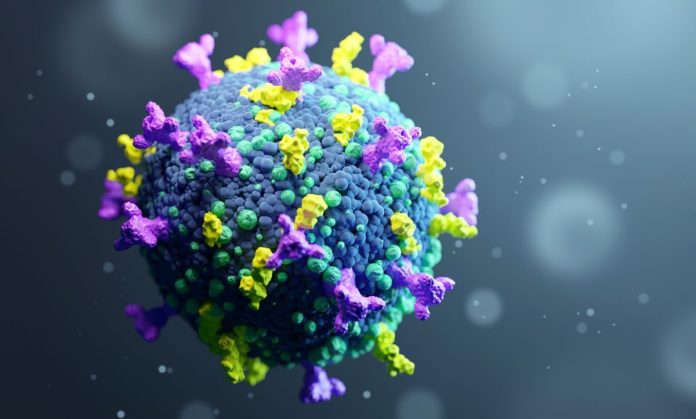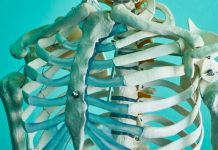Interdisciplinary treatments aimed at both mind and body are needed for these complex conditions
From early 2021, stories have emerged of people experiencing post-COVID-19 symptoms that were so debilitating it impacted their ability to work and live a normal life.
Thirty-one-year-old Rebecca Meyer spoke on CNN in January 2021 about her 11-month struggle with long COVID symptoms for 11 months, having contracted symptoms from an infection.
Prior to infection, she was a healthy woman with no underlying health conditions. However, 11 months into the sickness, Meyer maintained that she was still “very much in the symptom-management phase of my sickness.”
Her bedroom looked like a pharmacy due to the many medications she had tried.
Speaking on her health, Meyer’s voice cracked with emotion; she needs a feeding tube due to gastroenteritis from her post-COVID symptoms, and is very much out of her four children’s lives. At the time, she reported that she has been reliant on her boyfriend, who lost his job due to the pandemic, to take care of her and the children.
“I was an active mom of four. And now I don’t get out of bed. I don’t eat, I don’t spend time with my children like I need to. This can happen to you,” she said.
Despite running over two years into the pandemic, there has been little progress on our understanding of long COVID symptoms and patients affected by it have remained largely neglected. Meanwhile, the debilitating conditions that many long COVID patients are suffering from have persisted, and are growing as a new group of disabled individuals.
Young and Disabled
While most clear out their COVID-19 symptoms in days to a few weeks, recent studies estimate that around 1 in 8 people who have been infected will have persistent COVID symptoms, despite testing negative for COVID-19.
Doctors still do not understand the drivers behind these symptoms, nor why these people are affected. Many long COVID patients, also known as long-haulers, are younger in demographic, and previously had no underlying health conditions.
However, many are hit with a myriad of mental and physiological conditions, including symptoms common to acute-COVID such as cough, fevers, shortness of breath, headaches, fatigue, and muscle aches, as well as less common COVID symptoms including brain fog, severe fatigue, chest pains, depression and anxiety, pins-and-needles, heart palpitations, sleep problems, along with other strange conditions.
Not all long COVID symptoms are debilitating, but for some, suffering from long COVID could mean a complete change to their lifestyle, and possibly even a disability.
The disabilities caused by long COVID-19 are directly related to critical organs including the brain, heart, lungs, and muscles.
1. Brain impairment: long COVID-19 impairs brain function and causes nerve damage. Studies have shown that more than 30 percent of SARS-CoV-2 viruses attack nerves. Nerves are a reservoir of hidden viruses, and nerves are connected to internal organs. Many “long-haulers” experience brain fog including difficulty sleeping, headaches, and dulled thinking and memory.
2. Impaired heart function: fatigue is a primary symptom in long haulers as well as muscle aches and increased fatigue after exercise. Many suffer from reduced cardiac output, meaning they have to reduce the intensity of their exercise and some cannot exercise without putting their health at risk.
3. Impaired respiratory function: studies have found that long COVID patients have decreased lung function due to scarring and inflammation. This can lead to decreased oxygen uptake and shortness of breath from lowered blood oxygen levels.
4. Impaired muscle function: persistent immune actions against viruses damage cells, including muscle cells and tissue. Inflammation from the immune responses can trigger inflammation in muscle fibers and induce muscle weakness.
5. Impaired blood vessel function: inflammation in the body damages cells that line blood vessels, and can possibly impair oxygen supply to organs and muscles. This can cause fatigue and aches.
A Global Problem
Disabilities from long COVID, and debilitating vaccine injuries (which often share similarities to long COVID symptoms) are growing, and becoming a problem of both national and global concern.
Debilitating long COVID symptoms can make it difficult for people to enjoy social activities and hold down a job.
News reports have emerged of people with long COVID and the vaccine injured who have faced discrimination from work and were later layovered due to their condition.
In July, 2021 the U.S. Department of Health and Human Services listed long COVID as a disability under Titles II (state and local government) and III (public accommodations) of the Americans with Disabilities Act (ADA). The statement cited that individuals claiming for long COVID disability will be assessed individually by health experts to determine if their health problems are from long COVD.
Latest U.S. government figures revealed a staggering 385,000 people have been living with symptoms of long COVID for a year or more.
A study by Brookings estimated that around 4.5 million Americans with long COVID are out of work.
This not only impacts the American workforce but is also a significant global problem both in matters of labor and healthcare.
Studies from the Netherlands showed that COVID-19 and long COVID has driven up sick leave during the pandemic. During the pandemic, the Organization for Economic Co-operation and Development published policies, encouraging implementation of sick leave income for people suffering from COVID-19 symptoms to protect their income, health, and jobs during the COVID-19 crisis.
While this provided temporary relief to the people who needed paid leave as a safety net, it also invariably increased government spending, with most countries coming out of the pandemic seeing unprecedented inflation rates.
Health conditions as a result of COVID-19 and related problems are also contributing to a shortfall in labor. Given that the world is already burdened with labor shortage from two years of pandemic, and rapidly changing work environment and career outlooks, disabilities from long COVID and vaccine injuries only add fuel to the fire.
A study published before the pandemic showed that, by 2030, more than 85 million jobs could go unfilled because there aren’t enough skilled people to take them, this number is expected to be significantly higher coming out of the pandemic.
The World Health Organization has also reported that more than 6.4 million deaths from COVID-19 and related problems. News reports have shown that there are many more vaccine injured and those who have declined vaccinations who have lost their jobs.
The expectation for work has also shifted during the pandemic. After two years of mostly working remotely with unstable employment and income, people coming out of lockdowns are also reporting mental health problems. Some came to the conclusion that work is not as important as their health or mental wellbeing and have since postponed seeking employment.
Interdisciplinary Approach to Treat Both Mind and Body
Considering that long COVID-19 is an interdisciplinary disease with a myriad of conditions that affect multiple organs, holistic health approaches have been encouraged by clinicians to treat the symptoms as a whole.
Dr. Sandrock, a professor of critical care and infectious disease medicine at the University of California, Davis School of Medicine, also said that the only universal treatment for “long-term symptoms of COVID-19” is to “improve the quality of life,” including adjusting sleep and reducing stress.
A few options of integrative care have emerged in scientific literature to resolve long COVID.
Psychological Therapies
Long COVID is detrimental to mental health. Patients often report symptoms that may be synonymous with depression and anxiety, including insomnia and muscle weakness.
Fatigue is a primary symptom of long COVID. For the patients in a state of social isolation, as well as financial and relationship difficulties, their situation can worsen fatigue, which can further cause negative impacts on mental health, and quality of life, forming a negative spiral.
People with long COVID are encouraged to seek out counseling and interact with support groups for people sharing similar conditions.
Acupuncture
Acupuncture is a holistic and energy-based medicinal practice based on the understanding that the body and its organs correspond to different energies.
Energy in excess or deficiency can affect particular organs, causing imbalances to the body. Therefore, by inserting very thin needles into acupoints at different meridians, energy balances can be restored at different organs.
Acupuncture has long been acknowledged as a medical practice that can alleviate symptoms of chronic pain.
Studies have shown that acupuncture increases the release of neurotransmitters including serotonin and noradrenaline. It also promotes the release of endorphins and melatonin and improves immune function.
The practice reasons that mental illnesses are due to imbalances in energies in various organs,
Studies have shown that acupuncture can improve mental conditions including depression and anxiety. Research indicates that depressive symptoms may be alleviated through the release of serotonin and noradrenaline, and electroencephalography readings show electroacupuncture (a form of acupuncture) may be just as effective as amitriptyline without the drug side effects.
In people with anxiety, acupuncture enhances a sense of stillness, general restfulness, and unresponsiveness to painful stimuli. It also boosts the release of endorphin, a hormone related to the feeling of happiness and satisfaction, as well as melatonin, a hormone that modulates the circadian rhythm and improves sleep.
Electroencephalography readings showed that acupuncture increased alpha waves, a wave associated with a normal wakeful state where the subject is quietly resting.
Studies have shown that acupuncture reduces patients’ needs for preoperative sedatives and the use of acupuncture comes with reduced side effects in comparison to prescription drugs for pain.
For long COVID symptoms, acupuncture is suggested to stimulate the central nervous system. Specifically it reduces the “fight or flight” stress response of the sympathetic nervous system while stimulating the parasympathetic responses (“rest and digest”).
Studies on long COVID patients suffering from chest palpitation and shortness of breath—symptoms synonymous with anxiety—found that patients experienced a decrease in the severity of the symptoms following acupuncture sessions.
Rehabilitation Interventions
Rehabilitations including physical, occupational, and speech therapy to help patients return to daily life.
Studies on aerobic and pulmonary physiotherapy, found that it improves patients’ shortness of breath, anxiety, and fear of moving. High and low-intensity aerobic exercises increased appendicular muscle mass as well as handgrip strength in patients with long COVID.
Rehabilitation and nutrition programs can also prevent and improve loss of muscle mass in patients.
Chiropractic Therapy
Chiropractic therapy is a holistic therapy that focuses on the musculoskeletal system, especially the spine. Chiropractors believe that vertebrae can become misaligned or move out of their normal position, creating subluxations that put pressure on the tissues around them.
This pressure can affect not only the immediate joints but also other visceral organs and the whole body. Therefore, chiropractors believe symptoms of stiffness, dizziness, lack of energy, general malaise, posture imbalance, neck and back stiffness or soreness, spine muscle spasms, constant headaches, and lessening of mobility are all signs of subluxation.
Vertebrae can be realigned through skeletal manipulation, which is when chiropractors apply a force to the area that is misaligned, and chiropractors use various techniques to manipulate relevant joints.
Primarily, chiropractic therapy has been used to treat back pain, however several studies have indicated that they can also treat pain in joints and limbs, muscle pain and tenderness, insomnia, headaches, and fatigue.
Meditation
Meditation, a mental exercise to attain greater spiritual awareness, is an umbrella term for various practices including yoga, taichi, breathing, and mindfulness exercises, and many more.
Meditation has been associated with many mental and physiological health benefits.
Studies have shown that meditation improves symptoms of depression, anxiety, as well as concentration, and focus.
Physically, meditation has been shown to reduce inflammation and strengthen the immune system. Studies in immune-compromised (HIV and cancer) patients showed that meditation increased or reduced the decline of immune cells, and also prevented immune aging.
Mindful meditation have been suggested to regulate and restore immune signaling. Studies showed that meditation improved interferon messaging. Interferons are dysregulated in people with severe COVID symptoms and have been suggested to also drive vaccine injury. Restoring a robust interferon pathway may improve the symptoms in people suffering from long COVID and in people sharing similar symptoms.
Meditation and mindful exercises have been encouraged during the pandemic and for long COVID patients to recover from fatigue and mental distress.
Even minimal meditation improves mental health, studies have shown novice meditators who listened to a 10 minute meditation tape before attention tests received a higher score than people who did not meditate beforehand.
Some meditation guides recommend beginners start with two to five minutes of meditation whenever they want to regulate stress and emotions. However, given that meditation could mean various practices, everyone can experiment with the duration and frequency to see what works best for them.



